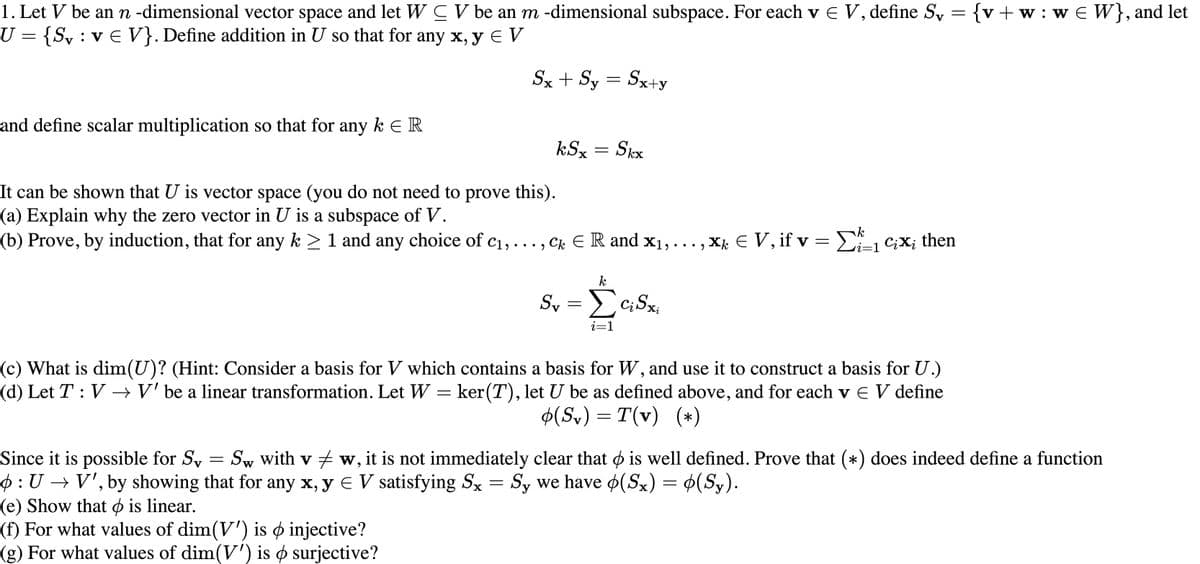1. Let V be an n-dimensional vector space and let W C V be an m -dimensional subspace. For each v E V, define S, = {v + w: w € W}, and let U = {S, : v E V}. Define addition in U so that for any x, y E V Sx + Sy = Sx+y and define scalar multiplication so that for any k ER kSx = Skx It can be shown that U is vector space (you do not need to prove this). (a) Explain why the zero vector in U is a subspace of V. (b) Prove, by induction, that for any k >1 and any choice of c1, ..., Ck ER and X1,..., X € V, if v = E1 Cix; then i=1 (c) What is dim(U)? (Hint: Consider a basis for V which contains a basis for W, and use it to construct a basis for U.) (d) Let T: V V' be a linear transformation. Let W = ker(T), let U be as defined above, and for each v e V define $(S,) = T(v) (*) Since it is possible for Sy = Sw with v + w, it is not immediately clear that ø is well defined. Prove that (*) does indeed define a function $:U V', by showing that for any x, y E V satisfying Sx = Sy we have o(Sx) = ¢(Sy). (e) Show that o is linear. (f) For what values of dim(V') is o injective? (g) For what values of dim(V') is ø surjective?
1. Let V be an n-dimensional vector space and let W C V be an m -dimensional subspace. For each v E V, define S, = {v + w: w € W}, and let U = {S, : v E V}. Define addition in U so that for any x, y E V Sx + Sy = Sx+y and define scalar multiplication so that for any k ER kSx = Skx It can be shown that U is vector space (you do not need to prove this). (a) Explain why the zero vector in U is a subspace of V. (b) Prove, by induction, that for any k >1 and any choice of c1, ..., Ck ER and X1,..., X € V, if v = E1 Cix; then i=1 (c) What is dim(U)? (Hint: Consider a basis for V which contains a basis for W, and use it to construct a basis for U.) (d) Let T: V V' be a linear transformation. Let W = ker(T), let U be as defined above, and for each v e V define $(S,) = T(v) (*) Since it is possible for Sy = Sw with v + w, it is not immediately clear that ø is well defined. Prove that (*) does indeed define a function $:U V', by showing that for any x, y E V satisfying Sx = Sy we have o(Sx) = ¢(Sy). (e) Show that o is linear. (f) For what values of dim(V') is o injective? (g) For what values of dim(V') is ø surjective?
Linear Algebra: A Modern Introduction
4th Edition
ISBN:9781285463247
Author:David Poole
Publisher:David Poole
Chapter6: Vector Spaces
Section6.5: The Kernel And Range Of A Linear Transformation
Problem 38EQ
Related questions
Topic Video
Question
Need help with part (g). Thank you :)

Transcribed Image Text:1. Let V be an n -dimensional vector space and let W C V be an m -dimensional subspace. For each v E V, define Sy = {v+w:w€ W}, and let
U = {S, : v E V}. Define addition in U so that for any x, y E V
Sx + Sy = Sx+y
||
and define scalar multiplication so that for any k E R
kSx
Skx
It can be shown that U is vector space (you do not need to prove this).
(a) Explain why the zero vector in U is a subspace of V.
(b) Prove, by induction, that for any k > 1 and any choice of c1, ..., Ck ER and x1, ..., X E V, if v = E C;X; then
Sy = c;Sx,
i=1
(c) What is dim(U)? (Hint: Consider a basis for V which contains a basis for W, and use it to construct a basis for U.)
(d) Let T: V →V' be a linear transformation. Let W
ker(T), let U be as defined above, and for each v E V define
=
$(Sv) = T(v) (*)
Since it is possible for Sy = Sw with v w, it is not immediately clear that o is well defined. Prove that (*) does indeed define a function
$: U → V', by showing that for any x, y E V satisfying Sx = Sy we have (Sx) = ¢(Sy).
(e) Show that ø is linear.
(f) For what values of dim(V') is ø injective?
(g) For what values of dim(V') is ø surjective?
||
W
||
Expert Solution
This question has been solved!
Explore an expertly crafted, step-by-step solution for a thorough understanding of key concepts.
This is a popular solution!
Trending now
This is a popular solution!
Step by step
Solved in 2 steps with 2 images

Knowledge Booster
Learn more about
Need a deep-dive on the concept behind this application? Look no further. Learn more about this topic, advanced-math and related others by exploring similar questions and additional content below.Recommended textbooks for you

Linear Algebra: A Modern Introduction
Algebra
ISBN:
9781285463247
Author:
David Poole
Publisher:
Cengage Learning

Elementary Linear Algebra (MindTap Course List)
Algebra
ISBN:
9781305658004
Author:
Ron Larson
Publisher:
Cengage Learning

Linear Algebra: A Modern Introduction
Algebra
ISBN:
9781285463247
Author:
David Poole
Publisher:
Cengage Learning

Elementary Linear Algebra (MindTap Course List)
Algebra
ISBN:
9781305658004
Author:
Ron Larson
Publisher:
Cengage Learning